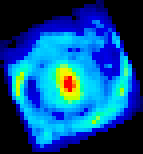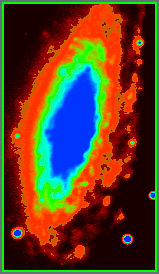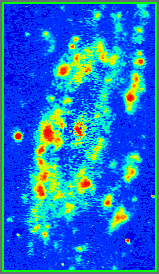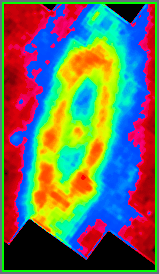The first image is the appearance of the galaxy
in optical light. This shows the distribution of the
*stars*.
The second is how the galaxy looks when imaged through
a narrow-band optical filter containing the hydrogen
alpha line plus a nearby nitrogen line.
This image shows the location of the
unobscured *ionized gas*.
These two optical images are from
Rick
Pogge's thesis.
The third image, the ISOCAM
image, shows the distribution
of hot dust grains.
There is a prominent ring of mid-infrared light
with a diameter of 0.5 arcminutes x 1.5 arcminutes
(2.2 kpc x 6.6 kpc).
One quarter of the mid-infrared radiation from
this galaxy comes from this ring.
Note that the ring is much more prominent in
the mid-infrared than in the H-alpha+[N II] image,
even though both the ionized gas and the hot
dust traces young massive stars.
The reason for this is that the optical
H-alpha+[N II] light is highly obscured
by dust, so it only shows the location
of H II regions without much dust in
front of them.
The mid-infrared radiation is not strongly
affected by foreground dust, so it gives a much
better picture of the true distribution of young
stars in this galaxy.
Notice the differences between these two images.
The left (eastern) part of the ring is also
quite bright in the H-alpha+[N II] map; the right (western)
side, however, is much fainter. The bright
H-alpha+[N II] sources on the western
ring of the ring lie *outside* the
ring and are not
part of the ring.
They only have faint counterparts in
the mid-infrared image, and therefore
are *intrinsically* less luminous
than the star forming regions in the ring.
They just look bright in the optical because
they don't have much dust in front of them.
The center of the galaxy, which is so bright
in the optical, is relatively faint in the mid-infrared.
This is because most of the newly formed stars
in this galaxy are in the ring, not in the center.
The stars in the center are mostly old, and do
not emit very much ultraviolet radiation.
Some of the mid-infrared emission in the bulge
of this galaxy is probably direct starlight, rather
than dust emission.
To return to Beverly Smith's web page,
click here
 A
mid-infrared image of the Sab galaxy NGC 4736,
from Smith and
Madden 1999,
proceedings of Astrophysics with Infrared Arrays: A Prelude to SIRTF
conference, ASP Conference Series, Volume 177, p. 216.
Note the mid-infrared bright bulge surrounded by
a circumnuclear ring. The radius of the ring
is approximately 45 arcseconds (1.3 kpc).
A
mid-infrared image of the Sab galaxy NGC 4736,
from Smith and
Madden 1999,
proceedings of Astrophysics with Infrared Arrays: A Prelude to SIRTF
conference, ASP Conference Series, Volume 177, p. 216.
Note the mid-infrared bright bulge surrounded by
a circumnuclear ring. The radius of the ring
is approximately 45 arcseconds (1.3 kpc).


